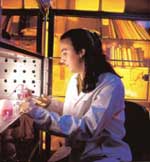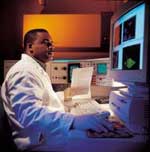Georgia Tech/Emory Center for the Engineering of Living Tissues
Georgia Institute of Technology (lead institution) and Emory University
![]()
Developing tissue-engineering technologies by harnessing discoveries from the biological revolution to significantly improve clinical therapies
| A National Science Foundation Engineering Research Center since 1998 |
The United Network for Organ Sharing has declared that, "The number one issue facing the transplant community is organ shortage." In focusing on tissue engineering, the Georgia Tech/Emory Center (GTEC) for the Engineering of Living Tissues is aiming to develop the core technologies required to confront the transplantation crisis and to build the tissue-engineering industry, including design concepts and evaluation techniques. The technologies that GTEC is developing will create biological substitutes for implantation into the body and/or the fostering of tissue regeneration and remodeling, with the purpose being to replace, repair, maintain, or enhance function. The Center is taking an integrated systems approach, harnessing discoveries from the biological revolution to significantly improve clinical therapies. This research will aid an emerging industry that is at the interface of biotechnology and the traditional medical implant industry and will provide the next generation of medical implants. GTEC itself is a unique partnership between Georgia Tech, a public institution with engineering strength, and Emory University, a private university with medical school expertise. These two institutions offer an ideal blend of knowledge and expertise to support the GTEC mission.
Research
GTEC's research strategy is to identify major barriers, develop specific approaches to overcome these barriers, and from this, establish core technologies for product development. There are three research thrusts cell technology, construct technology, and integration into living tissues. The major application areas are cardiovascular substitutes (e.g., blood vessels, heart valves), encapsulated cell therapies (e.g., bioartificial pancreas) and orthopaedic applications (e.g., bone, cartilage). The research activities in these three testbeds bridge all three thrust areas.
 |
| GTEC graduate student prepares an experiment in which endothelial cells are exposed to shear stress. |
The engineering of living tissues starts with the cell. Cell source is a major concern, and learning how to manipulate cells so as to exhibit the desired functional characteristics is part of the challenge. GTEC's strategy in cell sourcing is one that favors the use of allogeneic cells cells from a human source other than the patient. Such cells lend themselves to producing substitutes with off-the-shelf availability but need to be engineered for immune acceptance. Engineering the cells so as to exhibit the appropriate functional characteristics is another critical issue and can be done in two ways. One approach is through manipulation of the extracellular environment (i.e. the cell's external environment). The other way is through genetic engineering, a technology that is very much an ally of tissue engineering.
Construct technology addresses the next challenge: the development of a model tissue-substitute with an architecture and functionality that mimics the native tissue for which it is to be substituted. There are many approaches. One is a cell-seeded polymeric scaffold; another is a cell-seeded collagen gel. A key issue within construct technology is the development of cost-effective manufacturing processes. For any product concept to be commercially viable, there must be a scaleup from making one at a time to a production quantity of 100 to 1000 constructs per week. Product delivery and availability to the clinician is another critical issue in construct technology; cryopreservation is a technique that is being explored here.
Finally, a concept for a tissue-engineered product is moved into the living system. This will involve animal experiments initially, but ultimately will entail clinical trials. One of the most important issues here is immune acceptance. Much of what has been learned in the field of transplant immunology can help us understand implant immunology and the engineering of immune acceptance for tissue-engineered substitutes. Another critical issue is biocompatibility. GTEC believes that magnetic resonance imaging (MRI), used in a nuclear magnetic resonance (NMR) spectroscopic mode, has the potential to assess the viability/functionality of a cell-seeded implant. This assessment technology is now under development. The issues described form the basis of the strategy being implemented through GTEC. The expectation is that the result of this research will be core, enabling technologies that will serve as a foundation for the engineering of living tissues and the associated emerging industry.
Education
The educational goal for GTEC is to produce a new generation of students with a cross-disciplinary team perspective; the strategy is to use the tissue engineering industry as a platform for developing educational programs aimed at the emerging biology-based industries of the 21st century. This is being done through the efforts of a strong student council that has dedicated itself to K-12 outreach and mentoring of undergraduate interns. GTEC has an Education Advisory Council that meets twice a year to hear education progress and plans and to assist in the direction of education initiatives. GTEC's Industrial Educational Partners are a vital part of the education strategy through internships, panel discussions, and meetings with the GTEC faculty and students.
 |
| Flow cytometric analysis on human cells being conducted in GTEC laboratory. |
Curriculum advances are being addressed largely through the Joint Georgia Tech/Emory Biomedical Engineering Department. The curriculum includes an undergraduate minor in bioengineering at Georgia Tech, an MS and PhD in bioengineering at Georgia Tech, and a joint Georgia Tech/Emory PhD in biomedical engineering. The latter program includes problem-based learning and it integrates biology and engineering throughout the curriculum. Additionally, a minor in the management of biomedical technology is available to graduate students, and a new program on biotechnology public policy has been initiated. Undergraduate programs include Research Experiences for Undergraduates (REU), a summer internship for nationally recruited undergraduates, and an Undergraduate Research Scholars (URS) program that enables outstanding undergraduates from metropolitan Atlanta colleges and universities to participate in research for a full year. Lifelong learning initiatives include the development of web-based interactive courses for use at Georgia Tech and Emory as well as other universities and member companies. Plans include the use of video resources to further distribute short courses and workshops to the broader bioengineering community.
Industrial Collaboration and Technology Transfer
GTEC's industrial collaboration and technology transfer initiatives are centered around a strong group of Industrial Educational Partners who continue to guide GTEC in appropriate research directions. The program has been designed, not for financial support, but to maximize intellectual dialogue between industry and the Georgia Tech/Emory team. The basic agreement involves a sponsorship fee that entitles companies to participate in the program by directing research and being the first to know of developments within the research program. Partners have the opportunity to meet with GTEC administrators and suggest research initiatives at their twice-a-year meetings. One of these is the Industrial Educational Partners Symposium. This is a members-only gathering at which faculty and students present research reports. An annual workshop at Hilton Head, South Carolina, is held for academic and industrial participation and interaction. GTEC graduate students have many opportunities to learn through industrial internships at bioengineering companies.
Facilities
GTEC is a vital part of the Parker H. Petit Institute for Bioengineering and Bioscience (IBB) and, as such, has administrative and laboratory space in the new IBB building on the Georgia Tech campus. This $30 million facility, with 150,000 gross square feet and a 7000-square foot vivarium, opened in the summer of 1999. The facility enables faculty from the multiple disciplines of GTEC (biology, biomedical engineering, chemical engineering, chemistry, biochemistry, and mechanical engineering) to work in interactive laboratory settings. The Emory University School of Medicine also has excellent facilities, which includes the Yerkes Regional Primate Center.
The merging of science and engineering promoted by GTEC is made possible by the medical strengths of Emory University and the engineering strengths of Georgia Tech, the two major partners in GTEC. As part of the Parker H. Petit Institute for Bioengineering and Bioscience, with its 40+ faculty-member multidisciplinary group, GTEC promotes tissue engineering as a major research area of the Institute. GTEC works in cooperation with many Georgia Tech and Emory academic units.
![]()
Center Headquarters
Georgia Tech/Emory Center for the Engineering of Living Tissues
Parker H. Petit Institute for Bioengineering and Bioscience
Georgia Institute of Technology
315 Ferst Drive
Atlanta, GA 30332-0363
Tel (404) 385-0216 · Fax (404) 894-2291
Homepage: http://www.gtec.gatech.edu
Center Director: Dr. Robert M. Nerem
(404) 894-2768 · robert.nerem@ibb.gatech.edu
Deputy Director: Dr. Ajit P. Yoganathan
(404) 894-2849 · ajit.yoganathan@bme.gatech.edu
Manager, Industrial Relations: Dr. Ann Schmierer
(404) 385-2259 · ann.schmierer@ibb.gatech.edu
Administrative Manager and Director, Education & Outreach: Ms. Donna
E. Brown
(404) 385-0216 · donna.brown@ibb.gatech.edu
Financial Manager: Ms. Pam Luther
(404) 385-0464 · pam.luther@ibb.gatech.edu
NSF 00-137b